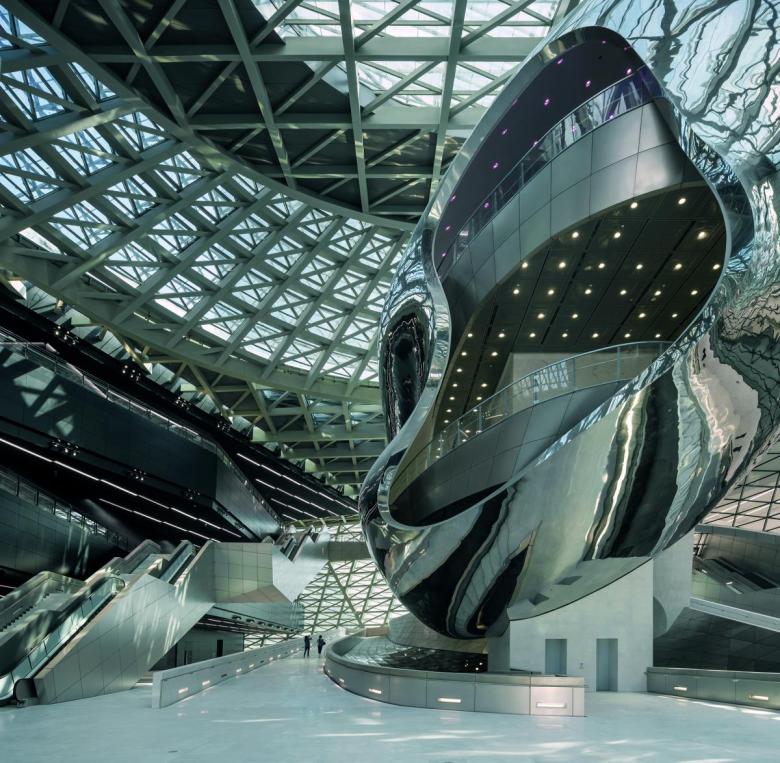Interview with Wolf D. Prix of Coop Himmelb(l)au
While his generation failed in its attempt to change society through architecture, Wolf D. Prix says today’s young talent does not even try to do so, preferring to take refuge in a romanticized past. What is urgently needed are fresh concepts for the next twenty years.
Mr. Prix, you really fired up the architecture scene as a young architect working with Helmut Swiczinsky and Michael Holzer. You became famous with your experiments, your visionary designs, and your aggressive rhetoric. How did that come about?
Rudi Dutschke once said that we are not the ones who have to change, but rather that society must change so that we can live in it. Th was the starting point for our deliberations: we wanted to create an architecture that adapts to people, not the other way around; an architecture that is light and capable of shifting, just like clouds. We fought back against the cold, inhuman, functionalist designs of the 1950s. In a very polemical way, we turned against the older architects and their ineffable stance as accomplices. “Architecture is not accommodating,” we wrote. We firmly believed that we could change society through architecture.
You used to believe in it? Was it all for nothing?
Take a look around: many things are actually worse today than in the 1970s. From a social perspective, my generation has surely lost. What we once dreamed of has not come true. Instead, we are currently experiencing a major backlash. A conservative architectural language is in demand now more than ever. Many take refuge in a romanticized past and build in Biedermeier style. Boxes with embrasures and shed buildings are cropping up everywhere. To me, that’s a clear alarm signal. And it fits in well that architects’ stance of accomplice and anticipatory obedience are also unbroken. I will not criticize anyone who accepts commissions from dubious clients in order to earn money and make a good living – I would lose all credibility for myself. After all, China is among the places where we are working successfully. But to present your boring investor projects as the future of architecture, or to build in China in a more Chinese way than the Chinese themselves – I find that obscene; that annoys me.
Right now, I probably sound very negative to someone of your generation. It’s not all bad. After all, we managed to establish freedoms with our buildings, and to provide exceptional spatial experiences. There is still hope that young architectural practitioners emerge who continue to work on solutions that guarantee a more peaceful, a freer, and a more imaginative life. Maybe we were duped by an error of judgment about the robustness of the structures, and it takes several generations for sustainable changes to prevail.
What do you mean by a conservative architectural language? Many young architectural practitioners here in Switzerland are interested in skilled crafts, in local building traditions and history. Sometimes they combine that with a clear awareness of problems like the climate crisis or urban sprawl. They advocate building with the existing fabric, regional value creation, and the use of local materials. Surely that cannot upset you. Is your criticism more targeted at buildings like, for instance, the headquarters of Germany’s Federal Intelligence Service (BND) in Berlin by Kleihues + Kleihues?
Horrendous! That thing is an expression of the attitude that prevails within. It’s a pity considering all those taxpayer funds that were used; the BND could have just as well moved into a military barracks. Neoclassicism originates from a typically bourgeois, reactionary attitude. It is an expression of faintheartedness, the architectural language of those who dare nothing.
The development you described is something I am critical of. I fear that under the pretext of ecology and economy, wholly conservative attitudes are creeping in. Regional value creation and the use of local materials may, for example, not be wrong, but the whole thing can quickly tip over into a right-wing nationalist position. That’s why it’s important that (young) architects do not adopt or implement something without reflection. They must understand that architecture has broad political, social, cultural, and economic implications.
You and many of your contemporaries were very engaged, especially as young architects. You developed projects solely out of political, social, and architectural interest, without a specific commission, without the prospect of receiving a fee or even mention in a major publication. Why is there less of this kind of commitment today?
Today’s generation is a bit spoiled, and lately there has been lots of talk about work–life balance. How that word gets me upset! We didn’t know anything like that in the 1970s. There’s no freaking free time in architecture. Anyone who becomes an architect just to get rich has chosen the wrong profession.
Materialistically, young people are better off today than perhaps ever before. And that’s a problem. No one wants to risk their well-being and go out on a limb, even if it means losing our freedom. Let me put it this way: guys like Trump, Orbán, or Erdoğan, like our Turkish government politicians in Austria – the civil rights protesters of the 1960s would not have stood by and simply watched what they do; they would have immediately taken to the streets. Think back to the Prague Spring – young people stood up and took enormous personal risks. I don’t see that in the West any more.
Werner Binotto, former cantonal government architect of St. Gallen, recently told me that we as a society must fail before any real change occurs.
That is of course an extremely pessimistic view of the future, but sadly I almost have to agree. For example, for years we have been demanding that no more south-facing apartments are built because, due to global warming, in five to ten years’ time these will be Kentucky Fried Chicken apartments. Yet builders, investors, and architects continue to build them as if nothing were wrong. The other day, a systems theorist told me that the degree of suffering was not high enough – an extremely nasty but astute criticism. It’s sad that we live in a society that has to suffer before it changes. What a failure of contemporary politics.
How can we make sure that more imaginative, visionary ideas are again developed?
Theoreticians, curators, and art historians should be banned from our architecture schools for at least the next five years. They ruin the ability of young architects to imagine a new society and new forms for it.
Do you really mean that? It surprises me to hear you say that. You are a very educated person, you deal with philosophy, politics, art, and music, and you frequently quote Jacques Derrida, Walter Benjamin, and even Marshall McLuhan.
That’s different. These days we are dealing with a retreat into theory that hampers the development of imaginative, innovative solutions instead of stimulating them. The intellectual climate in the 1960s was different. I sometimes think we had it easier. We had a very fertile breeding ground. We had, as you rightly say, backing from music, politics, and philosophy. I had some great teachers who sparked the exploration of those things and aroused my interest in them. Information was harder to come by back then. There was no Internet. That had its advantages: we read a lot and engaged in great detail with the fodder we got. The discourse was much less superficial.
Criticizing is easy. What needs to be taught at architecture schools?
Critical and well-reflected thinking! I have encouraged my children to speak up whenever they have something to say. Universities need to do the same thing: As I already said, young architects must not be allowed to behave in an unreflective manner and must again have the courage to take risks. My hope is that they cast off their anticipatory obedience.
What do you see as the biggest challenge we need to master in the coming years?
I currently wonder most of all about what architecture will look like after the COVID-19 pandemic. Will there be profound change or will everything continue as before once a vaccine is ready and available? How should we design public spaces in the future, how does social housing need to change so that we are better prepared for situations like the present one? In that regard, I hereby give official notice that I will soon write a weekly blog on Twitter – if President Trump can do it, I certainly can too.
Many say the COVID-19 pandemic will change the workplace. But digitization will probably have an even stronger impact.
That’s an important point. Especially the construction industry, which has been a laggard up to now, is facing drastic changes that will have not only economic but above all social consequences. In China, we have already successfully deployed robots – for prefabrication as well as on the construction site. That saves a lot of time and human resources, and major projects can be carried out much more economically – so it will become a reality. We submitted two research proposals in Austria; one dealt explicitly with the social consequences of the digitization of the construction industry. Both were rejected. That’s tragic. If the European construction industry and the political establishment fall asleep and miss this development, we are in danger of a rude awakening.
Unfortunately, the fact that we in Europe are now lagging behind also applies to other industries, too …
… the German automotive industry, for example, has allowed itself to become dependent on Tesla and other electric vehicle manufacturers. I prefer not to imagine what economic and social consequences this could have for Germany and Europe in the coming years. The impending success of electromobility could have been foreseen long ago. But drawing attention to the costs, the development of new technologies was not pursued. The explanation was that doing so would be too expensive. How I hate that argument! All this misery solely for the sake of short-term profit for stockholders. We must finally come to realize that sustainability has three pillars: the ecological, the economic, and the sociocultural.
Thank you very much, Mr. Prix, for the interesting conversation. I hope that many (young) architectural practitioners feel inspired and emboldened by your words.
This interview originally appeared as "Wolf D. Prix: «Die Gesellschaft, die wir uns erträumt haben, ist nicht zustande gekommen. Stattdessen erleben wir einen grossen Backlash»" on Swiss-Architects. Translation by David Koralek / ArchiTrans.



